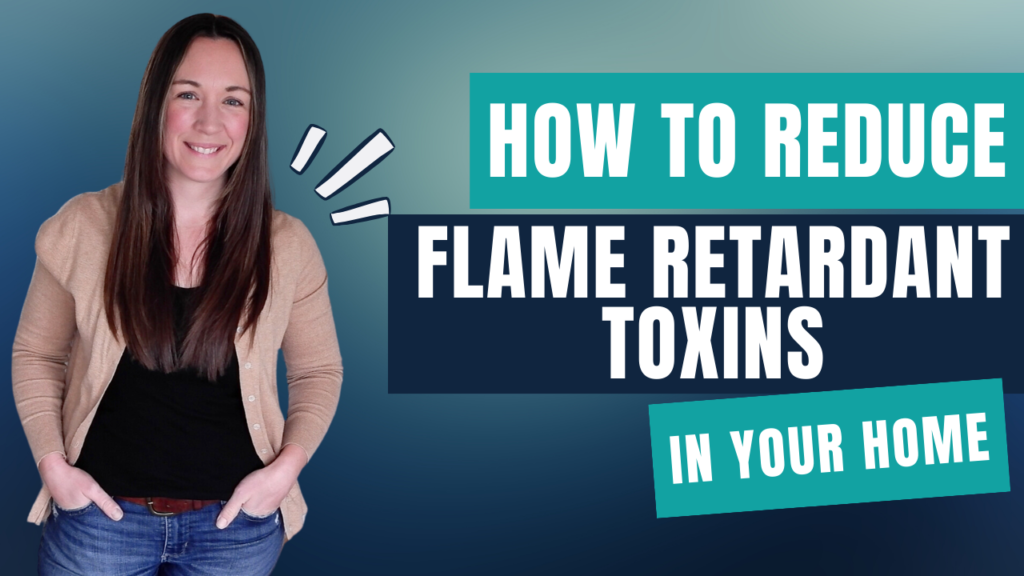
One of the toxins that gets a really scary face are flame retardant chemicals. This is a toxin that is covered on the news and I see it a lot on social media.
While it’s good we’re starting to hear about it more, I see a big problem with the WAY it’s being talked about. Instead of talking about the logical steps to reduce exposure to this toxin, focus is placed on the harm.
And yes, it’s good to hear about the harmful nature of a toxin. But without the other side of the coin, we can’t go about fixing the situation we’re in. And that situation is that we are exposed to toxic flame retardant chemicals throughout our day.
And what’s more important to understand is that our kids are being exposed more than we are due to their pajamas and clothing, strollers and car seats.
But if I can put a different spin on the sheer amount of exposure, it would be this:
If we are exposed frequently in our home and in spaces that we can control, then we have SO much opportunity to reduce the exposure through our habits and product swaps.
And if nothing else, know that flame retardants are highly prevalent in our dust from textiles and materials in our home. This means by following these few simple steps below, you’ll be well on your way to reducing exposure to flame retardant chemicals:
- Dust on a regular basis
- Use a HEPA filter vacuum at least once a week
- Run an air purifier (and make sure the filters are clean)
- Use a high quality furnace filter and change your HVAC furnace filter frequently
And after you take those steps, you can start using the information below to really ditch more of this toxin in your home for good.
WHAT ARE FLAME RETARDANT CHEMICALS?
Flame retardants are found in multiple products around the home. Specifically, they are found most often in items we sleep on and in and other products we are in very close contact with on a daily basis. Think mattresses, upholstered furniture, carpet, insulation, kids clothing, car seats, strollers and coating on electronic cords and products.
Brominated Flame Retardants are probably the most common example of a chemical of a flame retardant chemical which is added to household products. Bromine is the main component in this flame retardant and is usually added to building materials, furniture and other electronic items.
Another example of a flame retardant chemical is Polybrominated Diphenyl Ethers (PBDEs). Most products manufactured in the US before 2013 contain this chemical. However, some homes still contain furniture and products from before the total ban was in effect.
Hexabromocyclododecane (HBCD) is a flame retardant chemical most commonly found in polystyrene foam which is in building materials. This is the type of flame retardant that is most often found in dust present in homes.
Other flame retardant chemicals that are currently used in polyurethane foam found in furniture and children’s products are:
- EHTBB (Tetrabromobenzoate)
- BEHTBP (bis 2 ethylhexyl tetrabromophthalate)
- TPP (Triphenyl Phosphate)
- V6 (chloromethyl propane 1,3 – diyltetrakis)

HEALTH EFFECTS OF FLAME RETARDANTS
Endocrine & Thyroid Disruption: Brominated flame retardant chemicals have been known to cause issues with the adrenal glands as well as hormonal irregularities. (STUDY) These flame retardants are also being found in our environment as well as our bodies for long periods of time after exposure, meaning they are causing damage for extended periods of time. (STUDY)
Immune System Suppression: A study done on frogs in 2014 showed that pollutants such as flame retardant chemicals reduce their immune function and make it so they’re unable to fight off disease pathogens. The study also showed a weakened immune system in mice, mink and possibly people as well. (STUDY)
Carcinogenic: Flame retardant chemicals have specifically been linked to thyroid cancer, the fastest increasing cancer int he US. The link has been studied and prove in animals and now attention is being turned to humans, specifically women. Specifically this type of cancer is being linked to dust from polyurethane foam. (STUDY)
Reproductive Toxicity: Flame retardants cause problems in both men and women when it comes to reproductive toxicity. Lowered sperm counts and decreased reproductive hormones have been linked to PBDEs and other flame retardant chemicals in polyurethane foam (STUDY).
In women who had high urinary concentrations of flame retardant, there was a reduced likelihood in live birth and conception (STUDY).
Delays in Development: A 2017 study out of Oregon State University analyzed the behavior and exposure levels to flame retardants in children. The study found an increased likelihood in aggression, bullying, defiance and inability to problem solve linked to higher levels of flame retardant exposure (STUDY)
Reduced Neurological Function: Scientists at UC Davis Mind Institute studied flame retardant chemicals and linked them to delayed neurological function and cognitive process. They found it may also be a possible link to autism in children (STUDY)

ALTERNATIVES TO FLAME RETARDANT CHEMICALS THAT ARE SAFE
While many products have very few alternatives to flame retardant chemicals, there are more and more coming onto the market that are a healthier alternative.
Natural Wool: Many homes use this as an insulation option instead of flame retardant laden batting. You can read more about insulation choices that are natural and healthy here.
Some mattresses and furniture are also embracing natural wool as it is a great alternative to toxins and flame retardants.
Dihydroxybenxoic Acid: A plant based flame retardant that is found in both nuts and tea leaves. Specifically it comes from a substance found in buckwheat. This plant based flame retardant is currently being tested, but could be an exceptional alternative when it comes to creating toxin free furniture, mattresses and carpet. (Info)
TB117-2013 Label: This label is on upholstered furniture and when on furniture, indicates that it does not contain any flame retardants. This is really just in the state of California currently, but you can still find furniture manufactured around the US with this label.
Pajama Warning Labels: Kids’ pajamas WITHOUT flame retardants will have a bright yellow tag hanging from them in the store. It’s kind of ironic that they’re warning you that they DON’T contain chemical flame retardants as a safety precaution. This is a great way to shop for pajamas for your kids. Another alternative is to shop organic brands like Pact or Honest Baby or Burt’s Bees for sleepwear.
HELPFUL POSTS TO FIND PRODUCTS FREE FROM FLAME RETARDANTS:
Finding out all the places that toxic flame retardants can be in your home can be really overwhelming. My best advice is to focus on the items that you spend the most time in close proximity to as a starting place. You can even make a list (you know I’m a huge fan of lists!)
To begin reducing toxic flame retardants in your home, here are some great places to look at:
- Make Sure Kids’ Pajamas Don’t Contain Flame Retardants
- Replacing your Conventional Mattress with a Toxin Free Mattresses
- Get Rid of Toxic Pillows and Find the Healthiest Organic Pillow
- Start Researching How to Buy Non Toxic Upholstered Furniture
- If You Have Carpet, Consider Replacing it with a Smooth Surface Flooring or Toxin Free Carpet
- Swap Out Conventional Rugs with Natural, Low Toxin Rugs

The great news about a toxin that seems to be everywhere is that there are so many places you can reduce this exposure pretty quickly by picking a few places to concentrate on where flame retardants are prevalent.
Share this:
- Click to share on Facebook (Opens in new window) Facebook
- Click to share on LinkedIn (Opens in new window) LinkedIn
- Click to share on Reddit (Opens in new window) Reddit
- Click to share on Pinterest (Opens in new window) Pinterest
- Click to print (Opens in new window) Print
- Click to share on X (Opens in new window) X





Pingback: Non Toxic Portable Mattresses for Adults, Kids and Babies »
Pingback: Camper Remodel Ideas that are Toxin Free » Healthy House on the Block
Pingback: How Your Body Will Heal from a Home Detox »
Pingback: Healthy Homes Create Healthy Kids
Pingback: Toxin Free Luxury Vinyl Plank Flooring »
Pingback: Frequently Dirty Air Filter? Air Duct Cleaning is the Answers »
Pingback: Best Toys for a Healthy Home and Healthy Kids -